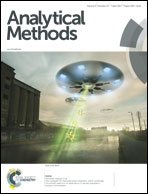Simultaneous quantitative analysis of three components in mixture samples based on NIR spectra with temperature effect
Abstract
The temperature effect is usually regarded as one of the interference parameters in the routine analysis of near infrared (NIR) spectra. In this paper, the Tchebichef image moment (TM) method was proposed and applied to the quantitative analysis of three components in mixture samples based on their raw NIR three-dimensional (3D) spectra with temperature effect. After the NIR 3D spectra were converted to their grayscale image, TMs with different orders were calculated as independent variants and employed to establish quantitative models by stepwise regression. The correlation coefficients of leave-one-out cross-validation (Rloo-cv2) for the three obtained models based on the calibration set were from 0.9952 to 0.9992 and the predictive correlation coefficients (Rp2) for the prediction set were from 0.9926 to 0.9977. Compared with the conventional partial least squares regression method, the proposed method has obvious advantages such as simplicity, reliability and accuracy, and may be a promising alternative approach for the simultaneous quantitative analysis of multiple target components in mixture samples by using NIR 3D spectra with temperature effect.



 Please wait while we load your content...
Please wait while we load your content...